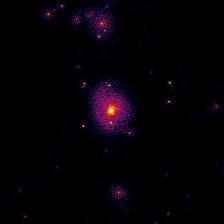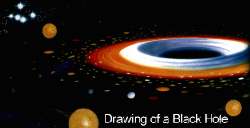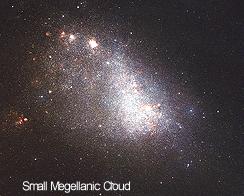Galaxy formation
From observations of the Cosmic Microwave Background we know that 100,000 years after the big bang, matter was still extremely uniformly distributed: variations in the density from point to point were just a few parts in 100,000. Everywhere the density was decreasing as the Universe continued to expand, but where the density was a bit higher than average, the expansion was slightly slower than usual, and the density decreased more slowly. Moreover, gravity slowed the expansion of high-density regions more rapidly than that of low-density regions, so the contrast between high- and low-density regions steadily increased. By the time the Universe was a few hundred million years old, the densest regions had ceased expanding and begun to collapse.
 The collapsing regions tended to cluster together. First knots of collapsing regions appeared. Then filaments of collapsing regions spread out from these knots and after a time linked the knots together. To the right is one frame from a computer simulation - not a photo - by the Virgo Consortium which shows this collapsing actually happening naturally.
The collapsing regions tended to cluster together. First knots of collapsing regions appeared. Then filaments of collapsing regions spread out from these knots and after a time linked the knots together. To the right is one frame from a computer simulation - not a photo - by the Virgo Consortium which shows this collapsing actually happening naturally.
Separating dark and ordinary matter
We believe that the ordinary matter of which we, the Earth and stars are made makes up less than 10% of the matter in the Universe. We don't know what the remaining 90% of matter is, but this "dark matter" differs from ordinary matter in being able to pass right through both ordinary matter and other dark matter, just like ghosts are supposed to pass through stone walls. As regions collapsed, their dark and ordinary matter tended to separate because the motion of a stream of ordinary matter was arrested when it banged into another stream of ordinary matter, while the dark matter originally associated with each stream flowed straight on. As they flowed, the streams of dark matter were teased out into long thin threads of matter that became more and more tangled with each other, so that after a billion years or so the dark matter formed a roughly elliptical ball rather like a ball of knitting wool. These balls are usually called dark halos.
 Meanwhile the streams of ordinary matter were flowing together like streams gathering to form a river. Gravity pulled the streams in towards the centre of the dark halo. We do not fully understand what happened next, but it seems likely that something like a gigantic star formed at the centre of the halo from the inflowing matter. Stars containing more than about 100 times the mass of the Sun are unstable. If slightly compressed, they collapse faster and faster until a black hole forms. It is likely that at the centre of many dark halos hundreds of thousands of solar masses were sucked into one or a few black holes. Gravitational interaction between these black holes will have caused some to merge and others to be ejected at great speed from the dark halo. Consequently, after a while some halos had no central black hole, while others had just one massive hole.
Meanwhile the streams of ordinary matter were flowing together like streams gathering to form a river. Gravity pulled the streams in towards the centre of the dark halo. We do not fully understand what happened next, but it seems likely that something like a gigantic star formed at the centre of the halo from the inflowing matter. Stars containing more than about 100 times the mass of the Sun are unstable. If slightly compressed, they collapse faster and faster until a black hole forms. It is likely that at the centre of many dark halos hundreds of thousands of solar masses were sucked into one or a few black holes. Gravitational interaction between these black holes will have caused some to merge and others to be ejected at great speed from the dark halo. Consequently, after a while some halos had no central black hole, while others had just one massive hole.
Forming disk galaxies
As the ordinary matter flowed inwards, it rotated faster and faster around the centre of the halo in the same way that water flowing out of a bathtub rotates faster and faster around the vortex that usually forms in the middle of the plug-hole. The rotation flattened the distribution of matter into a disk, rather like a CD. At the centre of many halos, the disk rotated around a black hole and hugh quantities of energy were released as matter spiralled through the disk and into the black hole. This energy powers Quasi-Stellar Objects (QSO or Quasars) and radio galaxies, which we directly observe back to very early cosmic times.
 Further out in the halo, stars began to form in the swirling disk of gas and the system began to be recognizable as a galaxy. These early galaxies would have looked something like the Small Magellanic Cloud: very rich in gas, rather irregular in shape and speckled with extremely luminous blue stars.
Further out in the halo, stars began to form in the swirling disk of gas and the system began to be recognizable as a galaxy. These early galaxies would have looked something like the Small Magellanic Cloud: very rich in gas, rather irregular in shape and speckled with extremely luminous blue stars.
Merging galaxies
Gravity was all the while pulling neighbouring galaxies together. Sometimes they were initially moving away from each so fast that gravity has still not brought them together, and may never do so. In other cases they soon fell towards each other and crashed into one another. The halos of dark matter then merged to form a similar but more massive dark halo, and the gas disks merged to form a more massive disk. The central black holes (if each galaxy had a black hole) will also have merged, amid a stunning release of energy, mostly in the form of neutrinos and gravitational waves.
As the gas disks merged, a significant fraction of their gas will have crashed down on the central black hole, greatly increasing its emission of electromagnetic radiation, from gamma-rays to radio waves. Other gas will have been catalyzed into forming stars: at least in the contemporary Universe, we find that galaxy mergers are associated with orgies of star formation, which power ultraluminous starburst galaxies.
Stars formed in the disks before they merged were not confined to a disk after the merger. Rather they will have formed a spheroidal distribution that extended from the centre of the new galaxy out to great distances.  This is how the Milky Way's stellar halo formed. It may also be how the Milky Way's bulge formed.
This is how the Milky Way's stellar halo formed. It may also be how the Milky Way's bulge formed.
It is likely that several stages of merging were involved in the formation of a massive galaxy such as the Milky Way. At each stage the dark halo grew more massive and bloated, and the fraction of ordinary matter tied up in stars rather than forming cold, free gas increased. Elliptical galaxies are the logical endpoint of this process in which the great majority of ordinary mass is locked up in stars and the residual gas is too hot to collapse into stars.
The Milky Way is falling towards our nearest large neighbour, the Andromeda Galaxy, M31. In about 10 Gyr the two systems will collide and merge. The end product of this merger is likely to be an elliptical galaxy.
Unfortunately, before this happens, the Sun will have expanded into a red giant star, swallowed the inner planets (including the Earth), blown off its outer layers to form a planetary nebula and become a white dwarf star. This white dwarf will then cool over aeons as it orbits through the hot rarefied atmosphere of the elliptical galaxies. The atoms of which we and the Earth are mode will probably end up in this atmosphere, at about a million degrees Kelvin.
At each stage in the merging process the characteristic rotational velocity of the galaxies increased, from about 50 km/s for the Small Magellenic Cloud through 220 km/s for the Milky Way to values in excess of 300 km/s for the largest elliptical galaxies. Something else that steadily increased was the fraction of matter that had been converted by stars from hydrogen and helium (which are the only chemical elements made by the big bang in significant quantities) to heavier elements such as carbon, oxygen, iron and uranium. Consequently, old stars and gas in galaxies that have small rotational velocities have small abundances of these `heavy elements'.
Galaxies first formed in the densest spots in the Universe. At these locations the merging process started earliest and proceeded fastest, and they are now rich in elliptical galaxies. They are, in fact, the centres of what observers call rich clusters of galaxies: giant regions, perhaps ten million light years in radius, within which gravity has successfully reversed the cosmic expansion, with the result that in a big cluster thousands of galaxies are careering at up to 1000 km/s through a diffuse sea of dark matter, gas at temperatures of about 10,000,000 degrees and stars that have escaped from individual galaxies.
When galaxies encounter each other at the enormous speeds characteristic of rich clusters, they do not merge. Rather, the gravitational field of each galaxy violently squeezes the other galaxy as the systems sweep past each other. As each galaxy bounces back from being squeezed, numbers of stars fly off into intergalactic space and any stellar disk that the galaxy has becomes appreciably thicker. The squeezing also trims cold gas from the outside of any gas disk. Moreover, as the blisteringly hot intergalactic medium streams past the fast-moving galaxies, material is steadily stripped from any gas disks, even in the absence of a close encounter with another galaxy. Both theory and observation indicate that these processes turn spiral galaxies into lenticular (S0) galaxies.
